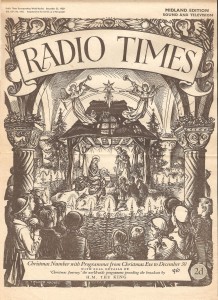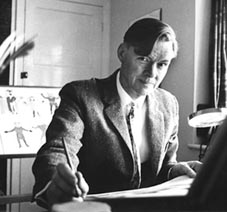I spent Saturday at the conference Who invented the “Shakespearean theatre”?, held at the University of Reading. I wrote about the conference in advance, and I’ll be writing more about the conference in a later blog (or two), but just now I want to focus on the artist C Walter Hodges, one of whose images was used to illustrate a point during the day. When I got home I went to my copies of two of his books to remind myself of them and found that by coincidence today, 26 November, is the eighth anniversary of Hodges’ death at the age of 95.
 I now have my father’s copies of Shakespeare and the Players and Shakespeare’s Theatre, two of the many he wrote and illustrated. It was the second of these, full of Hodges’ beautiful colour images, that my father showed me on its publication in 1964 and which sparked my own lifelong interest in Shakespeare in the theatre. Hodges was awarded the Kate Greenaway Medal for childrens’ book illustration for this book.
I now have my father’s copies of Shakespeare and the Players and Shakespeare’s Theatre, two of the many he wrote and illustrated. It was the second of these, full of Hodges’ beautiful colour images, that my father showed me on its publication in 1964 and which sparked my own lifelong interest in Shakespeare in the theatre. Hodges was awarded the Kate Greenaway Medal for childrens’ book illustration for this book.
Hodges continued to promote the idea of building a reconstruction of the Globe. In an article that appeared in the Birmingham Post in 1968, it was stated “Mr Hodges believes that a modern reconstruction of the Globe as working theatre …would teach us much not only about Elizabethan and Jacobean drama, but also about a tradition of presenting plays that is slowly reviving now that the picture-frame stage and its elaborate scenery have reached their limits”. He became an authority on the design and structure of the Elizabethan theatre, in 1970 being appointed technical adviser to the Globe Playhouse Trust. During 1971 the first World Shakespeare Congress passed a resolution expressing the hope “that a studied effort will soon be made to build a full scale reconstruction of Shakespeare’s Globe Theatre”. He lived long enough (until 2004) to see the reconstructed London Globe turn from dream to reality.
In the 1980s he was commissioned to provide conjectural illustrations of how scenes from the plays might have been staged, to be published in the New Cambridge Shakespeare editions of the plays. And he designed a series of stamps illustrating the Globe and other theatres of the period in 1995. If you’d like to see more of his work many examples are featured in the Gallery of the Shakespeare Out Loud website.
Tucked inside the back of Shakespeare’s Theatre I found two pieces of paper I hadn’t noticed before. One is the front cover of the Radio Times for Christmas week 1950, decorated with a black and white image by C Walter Hodges of a modern nativity play being performed in a church, complete with Christmas trees and an audience of children. Looking at the illustrations in the book, he includes a similar scene, an imagined version of a nativity play in a church during Shakespeare’s childhood.
 Hodges designed many covers for the Radio Times. With the cover is a letter from Hodges, dated 31 December 1950, responding to a letter my father had written in appreciation. In the letter he comments “It is very nice to know that one’s work gets noticed by people – for, with all the perplexities and difficulties of actually doing it, one sometimes forgets the “public”.
Hodges designed many covers for the Radio Times. With the cover is a letter from Hodges, dated 31 December 1950, responding to a letter my father had written in appreciation. In the letter he comments “It is very nice to know that one’s work gets noticed by people – for, with all the perplexities and difficulties of actually doing it, one sometimes forgets the “public”.
Hodges was a great believer in the importance of theatre: “the theatre as an institution is the pre-eminent arrangement whereby human beings work out the models of their own conduct, their morality and aspiration, their ideas of good and evil… If this is so, and it would be hard to deny, then the theatre must be seen as a most powerful instrument in the social history of mankind, and its own history must therefore be allowed a corresponding importance.”
In his foreword to the second edition of Shakespeare and the Players Hodges explains why he felt so drawn to these particular theatres: “for the first time, an important part of a nation’s cultural life was entirely created …by common citizens, of the sons of tradesmen from side streets and country towns, working together on their own”.
He went on: “there is still no certain knowledge about what Shakespeare’s theatre looked like in all its corners,…perhaps these may help to explain or justify, or even pass on to others, the infection I have so much enjoyed”. It is certainly a subject that continues to fascinate many.




When we were excavating the Rose in 1989 I met many Shakespearean scholars but Walter stood out as an independant and was so modest with his advice and support. Not only did he provide wonderful cartoons of the dig but also did some serious reconstruction drawings for us. There was a large gathering at his memorial service in Lewes that was ample testimony to his great friendliness, skill and knowledge.
I had the pleasure of meeting Mr. Hodges at Wayne State University in Detroit ~1985.
He was a beautiful, kind man, and amazingly spry for his late 70s. He had an amazing sense of the space, and how it could be blocked. I was humbled and grateful for his own humility, and for his abilities as an illustrator, and for his candor and knowledge to understanding and blocking Shakespearian plays.